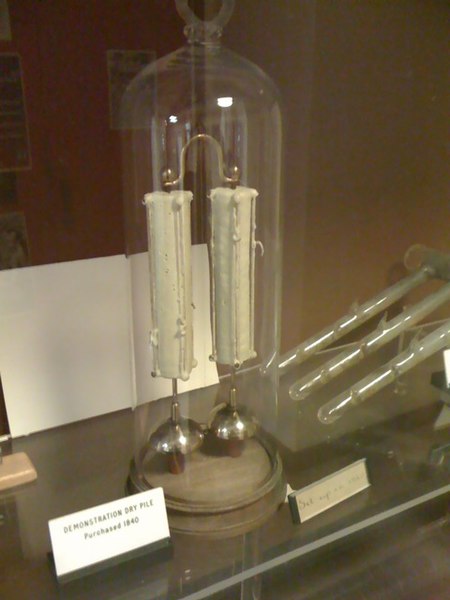The Mystery of the 175-Year-Old Battery-Powered Bell
The following is certainly a so-called “first-world problem,” but you’ve probably experienced it: you wake up in the morning and grab your phone, only to notice that it didn’t charge overnight. You’re staring at the battery indicator, reading 7% in an ominous red, and you’re wondering how you are possibly going to make it throughout the day. Batteries seem to be an increasingly important function of our everyday lives, and having one that’s run out can spark a panic. But, alas, most of them can’t make it more than a day or two.
And then there’s the Oxford Electric Bell, pictured below. It’s a battery-powered bell (hence the name) and it’s been ringing for more than 175 years. That’s pretty great for a battery!
But we’re not entirely sure of what it’s made of — or when it will run out of power.

In the early 1800s, a physicist named Giuseppe Zamboni (no relation to the guy who invited the ice rink cleaning machines) invented something called a “dry pile,” which, per Vice, were early batteries that “use alternating discs of silver, zinc, sulfur, and other materials to generate low currents of electricity.” The amount of electrical output is low — you can’t power a cell phone this way, sorry — but reliable at those low levels. At some point before 1840, a London-based instrument-making company called Watkin and Hill put together the device seen above. The two candlestick-looking things are the dry piles — that is, the battery part of the device, and toward the bottom are two bells. Hanging between the two is a tiny metal clapper — a 4mm metal sphere — that moves back and forth, striking the bells. The practical value of an auto-ringing bell that never stops ringing has been lost to time, but as a scientific curiosity, the bell found an audience quickly. In 1840, a professor at Oxford named Robert Walker purchased the bell (as seen on the left-most sign in the image above) and put it on display.
It’s been ringing ever since, for the most part. And we generally understand why. As Menta Floss explains, “As the clapper strikes and rings one bell, the corresponding dry pile charges and electrostatically repels it. The clapper then swings toward the other bell, and the same thing happens.” The whole back-and-forth dinging takes very little power, allowing the experiment to run seemingly forever, and the device recharges itself to a degree as well. It’s not a perpetual motion machine — some energy is lost due to the resistance of the air between the clapper and the bell — so eventually, the bell will stop tolling. In fact, when the humidity gets high enough, the bell stops, but only temporarily; once the humidity falls again, the bell will restart all on its own. In total, the bell has dinged an estimated 10 billion times.
But what’s in the dry piles? While we have a general idea, we don’t know the exact makeup and we probably won’t for a very long time. When Robert Walker obtained the device, he didn’t find out what Watkin and Hill used on the inside, and that’s never been recorded. It’s easy enough to figure out — all we’d need to do is peel off some of the casing and look inside — but as Vice notes, that’s not a great idea: “Researchers would love to know what the battery is made of, but they are afraid that opening the bell would ruin an experiment to see how long it will last.” And per some estimates, it could ring for another decade; sooner or later, the battery will run out of energy. So, ultimately, we’ll find out what’s inside.
Today, the bell is on display at the Clarendon Laboratory at the University of Oxford, where it just keeps on dinging. If you stop by, don’t expect to hear it, though. Even in the best conditions, it’s barely audible and encased in glass to help further dampen the sound, making it effectively inaudible to anyone passing by.
Bonus fact: The Oxford Electric Bell isn’t the only device that keeps on going despite a lack of outside help. In 1864, an Australian watchmaker named Arthur Beverly created a clock that uses changes in air pressure to power its parts. As Atlas Obscura explains, “an airtight box inside the clock expands and contracts throughout the day pushing on a diaphragm. It takes only a six-degree Celsius temperature variation over a day to raise a one-pound weight an inch. This, in turn, descends, powering the clock.” The clock hasn’t been wound since Beverly first put it on display; it’s only stopped for mechanical upkeep, or in the rare case when ambient temperature fluctuations don’t hit that six-degree Celsius threshold. But even in that case, the Beverly Clock will start up again on its own once the temperature changes enough.
From the Archives: Pedaling to Freedom: How a Brazilian prison charges car batteries.
